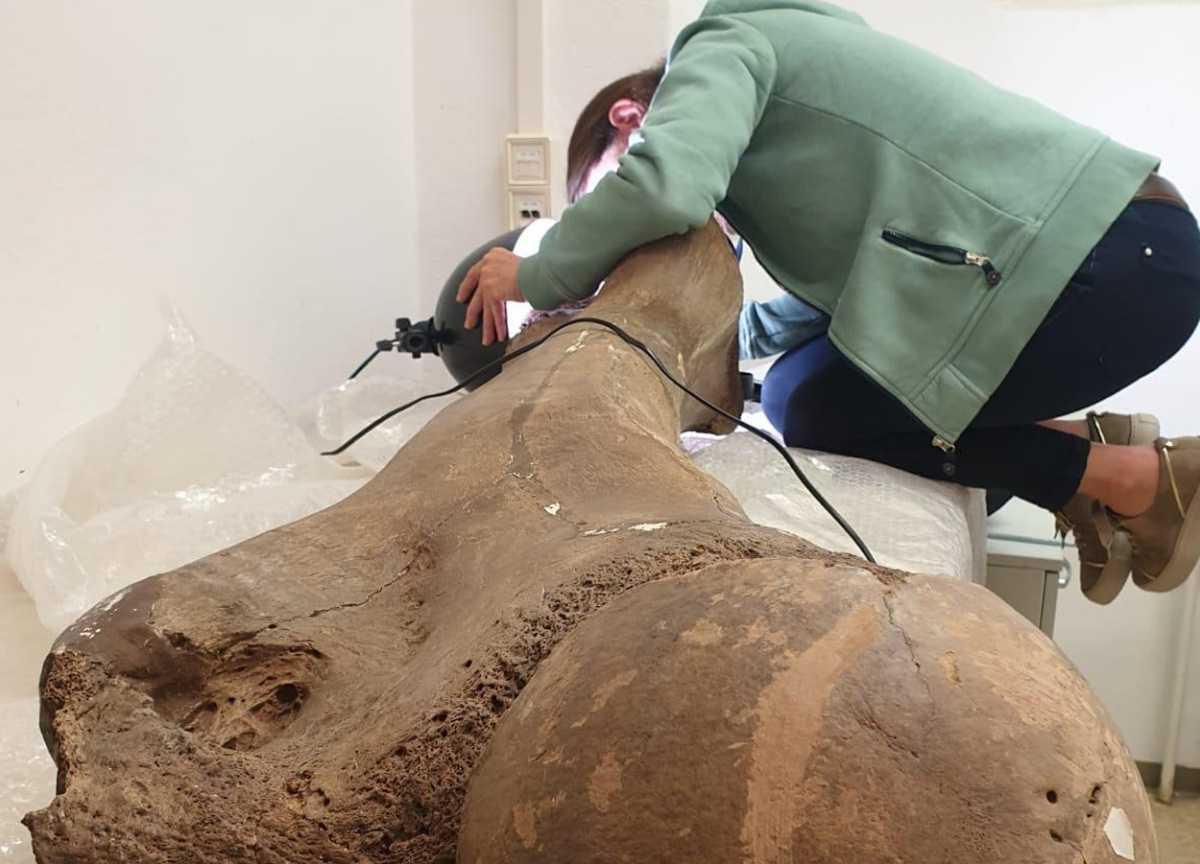A study at the Middle Palaeolithic site of Neumark – Nord, located near Leipzig, Germany, has provided the first indisputable proof of elephant hunting by early humans.
Neumark – Nord was first discovered in the 1980’s, revealing the remains of at least 70 straight-tusked elephants over a decade of excavations in a gigantic lignite pit, which had been well preserved over the last 125,000 years in the fine-grained lake sediments present there.
The European straight-tusked elephant was the largest land-living animal at the time – with shoulder heights of up to 4 metres and body masses of up to 13 tonnes. The animal by the scientific name of Palaeoloxodon antiquus, was characterised by its unusually long and essentially straight tusks.
Palaeoloxodon antiquus roamed the landscapes of Europe and Western Asia in a period 800,000 to 100,000 years ago. It was the largest land mammal of the Pleistocene epoch, a period that began three million years ago. Straight-tusked elephants were not only significantly larger than today's African and Asian elephants, but were even bigger than the also extinct woolly mammoth.
It has been unclear to date, whether prehistoric hominins actively sought out and killed such elephants or simply scavenged from the carcasses of animals that had died a natural death
A zooarchaeological study by researchers from the Johannes Gutenberg University Mainz (JGU), the Leibniz-Zentrum für Archäologie (LEIZA), also based in Mainz, and Leiden University in the Netherlands, analysed an assemblage of European straight-tusked elephant remains from Neumark – Nord.
This revealed that Neanderthals deliberately hunted down and slaughtered European straight-tusked elephants in much larger social groups than had been previously assumed, whose meat and fatty tissue represented an important source of nutrition.
Unusual pattern among the Neumark-Nord straight-tusked elephant remains
Researchers examined the extensive archaeological material from Neumark-Nord some 15 years ago. For them, this accumulation of elephant remains exhibited an unusual pattern in that the mortality profile seemed anything but normal.
The remains were almost exclusively from adult individuals and conspicuous among these was a pre-dominance of male animals. This pattern had not been observed before – neither in fossil nor in living elephant populations – and was difficult to explain.
When Professor Sabine Gaudzinski-Windheuser began inspecting a selection of the elephant bones in early 2021, she immediately identified traces of what might have caused the peculiarity of this assemblage: human hunting.
"The detection of clear and unusual lesions in the bones induced us to undertake a more detailed analysis of the elephant remains," said Gaudzinski-Windheuser, Professor of Prehistoric and Protohistoric Archaeology at JGU and Director of the Archaeological Research Centre and Museum of Human Behavioural Evolution MONREPOS, an institute run under the aegis of LEIZA.
Given the uniqueness of the material and the possible implications of the study, the Dutch and German team members decided to analyse the whole assemblage, which consisted of thousands of bones and bone fragments.
Unsurprisingly, this turned out to be a very time-consuming project. They were busy for months opening the large crates in which individual elephants are stored in the reserves of the State Museum of Prehistory in Halle, team-lifting the large and heavy bones to view their surfaces.
They also had to handle every piece of bone, identify its location in the skeleton, locate anthropogenic and/or carnivore modifications, and document any apparent changes. "In total, we looked at 3,122 faunal remains of European straight-tusked elephants that had been deposited at the Neumark-Nord site," said Dr. Lutz Kindler, research associate at MONREPOS.
Hunting massive probosicideans to sustain nutritional needs
The archaeological analysis focused on how the lesions were distributed across the skeletal remains. The conclusion reached was that hunting of these Ice Age megafauna in this area continuously occurred over a period of 2,000 years, for dozens of generations. "This constitutes the first clear-cut evidence of elephant hunting in human evolution," commented Professor Wil Roebroecks of Leiden Uni-versity.
Adult male individuals, much larger than the females, are overrepresented in the assemblage, probably because, as with present-day elephants, male adult elephants kept to themselves. Compared to females, they were easier to approach closely without the protection of a herd. Since they were also much larger, hunting them would have yielded much higher returns, for significantly less risk.
Neanderthal cooperation and group size
Hunting these large animals demanded close cooperation between the participating group members, just like prey processing, which entailed extensive butchering, including removing meat scraps from the long bones as well as the fat rich foot cushions. Processing may also have entailed drying products for long-time storage.
The authors calculate that a ten tonne elephant – not the largest one at Neumark-Nord – could have yielded a minimum of 2,500 adult Neanderthal rations of 4,000 kcals, consisting of a safe mixture of protein and fat from one animal only.
These figures are important as they suggest that Neanderthals, at least temporarily, congregated in groups much larger than the about 25 individuals usually seen as the maximum size of a local group and/or that they had cultural means for large-scale food preservation and storage.
The authors leave both options open, but emphasise that both are socially and cognitively important findings, which contribute significantly to our understanding of the range of variation in Neanderthal behaviour.
The ongoing work of the teams from Mainz and Leiden includes a substantial re-analysis of the rich assemblages excavated in the 1980s and 1990s. This has, for instance, yielded evidence for close range hunting of deer by Neanderthals, in the form of the earliest known hunting lesions on bones.
In 2021, the group published high-resolution data demonstrating that Neanderthals visibly impacted their environment. With their arrival in the Neumark-Nord region, woodland receded, and open vegetation came to dominate the area during the roughly 2,000 years of their presence, associated with their abundant use of fire. This constitutes the earliest clear case of landscape modification in human evolution.
Johannes Gutenberg Universitaet Mainz
Header Image Credit : Lutz Kindler, LEIZA


